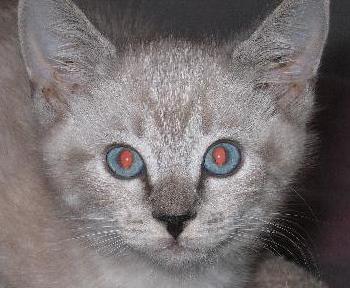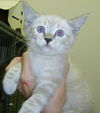Welcome to Pet Rescue By Judy!
401 South Laurel Avenue
Sanford, FL 32771
(407) 302-4497
info@petrescuebyjudy.com
Jared the Birman Kitten's Web Page

| My Rescue |
| Login to Remember your Favorite Animals and Breeds! |
Name: Jared the Birman Kitten
Status: Adopted!
Adoption Fee: $200
Species: Cat
Breed: Birman / Mixed (medium coat)
Color: Gray Tabby
Sex: Male (neutered)
Current Size: 1.5 Pounds
Potential Size: 9 Pounds
General Potential Size: Medium
Current Age: 16 Years 8 Months (best estimate)
Activity Level: Highly Active
Indoor or Outdoor: Indoor Only
Good with Cats: Yes
Declawed: No
Housetrained: Yes
Microchipped: Yes
Jared the Birman Kitten's sister, Judy the Kitten (adopted) can also be seen on our website.
Description:
Mmmmm, isn't Jared absolutely beautiful? He was found on the side of the road with his littermates. Looking at his markings, we think that he has some Birman in his family tree. With those blue eyes, oh my! What a doll he is!
10/26/08 Foster update:
Jared definitely has the looks! Enjoys playing with his sister Judy and being combed.
12/12 Foster Update:
Besides having exquisite looks , Jared's personality is mellow . Always greets me purring.
According to www.cat-lovers-only.com, many people think that the beautiful Birman breed originated from cats that guarded the Burman temples.
This breed is even rumored to have helped the Burmese monks fight off attackers. During that time, as the story goes, a Birman's coat turned the golden color of the goddess the monks worshiped, except for his paws which stayed pure white. Of course, less fanciful cat lovers say the Birman is simply a French relative of the Himalayan cat breed.
Although no one is completely sure where the Birman breed came from, all cat fanciers agree that it is definitely an older breed. Some breeders say the Birman is closely related to the Siamese cat, since it resembles a slightly stockier Siamese in appearance.
In fact, more than one person has said that when the pure white Burman temple cats changed color, it was probably because a stray Siamese cat fathered a few litters of kittens.
In the nineteen twenties, the Birman cat reached Europe. A single female survived the long voyage from Burma to France and gave birth to a female kitten who is the ancestor of today's Birman cats. This cat was most likely crossed with a Siamese cat.
After World War II, the Birman was in grave danger of extinction, as only one known pair of Birmans had survived the German occupation. The breed was again outcrossed with another cat to avoid extinction, although this time the Persian was most likely used.
With all of the inbreeding that was done to save the Birman breed, it would be no surprise if these cats were prone to several hereditary diseases. However, the breed is surprisingly healthy overall.
You should be aware that most of the members of the Birman cat breed are prone to anesthesia sensitivity. Add this to the fact that Birmans can be either A or B blood type, and this can mean trouble on the operating table. The breed is also prone to developing hairballs.
Since Birmans are prone to hairballs, you may want to feed your cat a diet that is formulated to aid in hairball prevention. If he becomes lethargic and does not eat as much as he normally does, you should consult your veterinarian about treating him for hairballs.
Since this breed is not as active as some other breeds, you may also need to ask your veterinarian about feeding your cat a weight control diet if he becomes overweight.
While this breed is a longhair breed, it does not have a heavy coat. As long as you comb your Birman's hair once a week, you should not have a problem with the coat matting. Hairball control is another matter, and more frequent grooming can go a long way in helping with that problem.
These cats are still somewhat playful, curious and affectionate, like their Siamese relatives, but are more laid back and relaxed than the Siamese, like their Persian relatives.
If you are looking for a cat that isn't quite as demanding and attention seeking as some of the more affectionate breeds, but also isn't too standoffish, the Birman cat breed is a good choice.
Mmmmm, isn't Jared absolutely beautiful? He was found on the side of the road with his littermates. Looking at his markings, we think that he has some Birman in his family tree. With those blue eyes, oh my! What a doll he is!
10/26/08 Foster update:
Jared definitely has the looks! Enjoys playing with his sister Judy and being combed.
12/12 Foster Update:
Besides having exquisite looks , Jared's personality is mellow . Always greets me purring.
According to www.cat-lovers-only.com, many people think that the beautiful Birman breed originated from cats that guarded the Burman temples.
This breed is even rumored to have helped the Burmese monks fight off attackers. During that time, as the story goes, a Birman's coat turned the golden color of the goddess the monks worshiped, except for his paws which stayed pure white. Of course, less fanciful cat lovers say the Birman is simply a French relative of the Himalayan cat breed.
Although no one is completely sure where the Birman breed came from, all cat fanciers agree that it is definitely an older breed. Some breeders say the Birman is closely related to the Siamese cat, since it resembles a slightly stockier Siamese in appearance.
In fact, more than one person has said that when the pure white Burman temple cats changed color, it was probably because a stray Siamese cat fathered a few litters of kittens.
In the nineteen twenties, the Birman cat reached Europe. A single female survived the long voyage from Burma to France and gave birth to a female kitten who is the ancestor of today's Birman cats. This cat was most likely crossed with a Siamese cat.
After World War II, the Birman was in grave danger of extinction, as only one known pair of Birmans had survived the German occupation. The breed was again outcrossed with another cat to avoid extinction, although this time the Persian was most likely used.
With all of the inbreeding that was done to save the Birman breed, it would be no surprise if these cats were prone to several hereditary diseases. However, the breed is surprisingly healthy overall.
You should be aware that most of the members of the Birman cat breed are prone to anesthesia sensitivity. Add this to the fact that Birmans can be either A or B blood type, and this can mean trouble on the operating table. The breed is also prone to developing hairballs.
Since Birmans are prone to hairballs, you may want to feed your cat a diet that is formulated to aid in hairball prevention. If he becomes lethargic and does not eat as much as he normally does, you should consult your veterinarian about treating him for hairballs.
Since this breed is not as active as some other breeds, you may also need to ask your veterinarian about feeding your cat a weight control diet if he becomes overweight.
While this breed is a longhair breed, it does not have a heavy coat. As long as you comb your Birman's hair once a week, you should not have a problem with the coat matting. Hairball control is another matter, and more frequent grooming can go a long way in helping with that problem.
These cats are still somewhat playful, curious and affectionate, like their Siamese relatives, but are more laid back and relaxed than the Siamese, like their Persian relatives.
If you are looking for a cat that isn't quite as demanding and attention seeking as some of the more affectionate breeds, but also isn't too standoffish, the Birman cat breed is a good choice.
Other Pictures of Jared the Birman Kitten (click to see larger version):
 25.8k |
 33.6k |
Copyright © Pet Rescue by Judy





